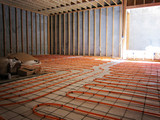Pros and Cons of In-Floor Radiant Heating

Radiant flooring can be an efficient and effective way to heat your home. It has actually been around for centuries, but technology has improved to the point where it has become a viable and popular heating option for homes in the United States. There are two basic types of radiant floor heating to consider:
1. Electric Radiant Heat (most popular): Individual wires or wire mesh are sandwiched between the finish layer and the substrate.
2.
Hydronic Radiant Heat and Radiant Air Floors: Hydronic
Radiant Heat uses hot water running through tubes under the floor, and
Radiant Air Floors use tubes of hot air running under the floor.
Basics of In-Floor Radiant Heat
Knowing some of these can help you determine if it’s even a possibility for you.
• Not just Electric Radiant Heat, but all of these use
electricity. Their use will have a cost factor.
• Floors can heat up to 95 degrees F. This might exceed some floors' tolerances.
• Electric radiant heating systems work best when
installed under
porcelain, ceramic, stone and marble flooring. These floors
are excellent heat conductors, and do not expand or contract with heat, so
they are resistant to any warping or cracking.
• Hardwood, vinyl and carpet do not work well with
electric radiant heating because they are not good conductors of heat, and
actually behave like insulators, blocking heat from the room.
All home heating options all have basic pros and cons, and these can help
you determine if you even want to use radiant floor heating:
Pros:
• In-floor radiant heat systems directly heat the
intended area, and don’t lose heat as warm air travels through vents or
baseboards.
• They can last up to 35 years, longer than any
furnace.
• They can be cost efficient because the heat radiates
upward, making the entire room feel more comfortable, allowing a lower
thermostat setting.
• They provide more flexibility in placing furniture
around the room without concern for heat vents.
• Due to the lack of forced air, they are silent. This
is also a benefit for allergy sufferers because dust, dirt, pollen and other
allergens are not blown into the home.
• Eventually heat is evenly distributed throughout a
room creating a feeling of warmth.
• They are an excellent option for heating home
additions without having to extend HVAC ducts.
• Concrete will retain the heat for long periods of time
after the power is turned off.
• Higher peak periods are those when people are home,
evenings, weekends, etc. radiant heat can be used during off peak hours
because its flooring sources retain the heat for longer periods of time,
they are “conductors” of heat. Cheaper rates for off peak hours.
Cons:
• The upfront cost may be higher than the cost of
replacing a furnace.
• Many contractors are not familiar with their
installation, so you may have to look around to find a company that is
experienced in the process.
• They are difficult to install retroactively, after a
home or room has been built. It’s not impossible. Replacing the transmission
in your car is also not impossible, but it is a big reason why people get
new cars.
• Most floor coverings will list limitations on the
temperatures at which radiant heating can be set. These are usually pretty
reasonable, like “Not over 98 degrees,” but it is something you would have
to look into when shopping for a floor.
• They are a slow-build heater, taking some time to warm
up your home. The heat radiates into the floor and continues to spread
upward, but not at the same velocity and speed as air forced through a vent.
Ergo, they are more effective warmers of the floor than an entire home.
• The cost of repairs may be high because the heating
coils or pipes which may need attention are located beneath the flooring.
• Their lack of ductwork is not efficient for cooling.
Air conditioning in a radiant heated room is typically done with a heat pump
or condenser separate from the radiant system
• A dehumidifier may be required to prevent condensation
on the floor.
Always check with a professional if you’re considering installing radiant
heat in your home. Building a new home, remodeling an existing property or
building an addition are all great times to consider installing a radiant
heating system, and it can be an important selling point for your home!
– – – –
David is has written and made videos about flooring products and installation since 2011 at Floors To Your Home (.com), where he is also the PPC Manager, a Researcher, a Website & Marketing Strategy Team member, Videographer, Social Strategist, Photographer and all around Resource Jito. In my spare time I shoot and edit video, put together a podcast, explore film history, and mix music (as in ‘play with Beatles multi-tracks’). Connect with
W. David Lichty
Follow Team Floors To Your Home on Facebook

 Brown Tone
Brown Tone
 Unfinished
Unfinished
 Red Tone
Red Tone
 Golden Tone
Golden Tone
 Gray Tone
Gray Tone
 Light Tone
Light Tone
 Medium Tone
Medium Tone
 Dark Tone
Dark Tone
 Brown Tone
Brown Tone
 Red Tone
Red Tone
 Golden Tone
Golden Tone
 Gray Tone
Gray Tone
 Light Tone
Light Tone
 Medium Tone
Medium Tone
 Dark Tone
Dark Tone
 Brown Tone
Brown Tone
 Red Tone
Red Tone
 Golden Tone
Golden Tone
 Gray Tone
Gray Tone
 Light Tone
Light Tone
 Medium Tone
Medium Tone
 Dark Tone
Dark Tone
 Multi Color
Multi Color



